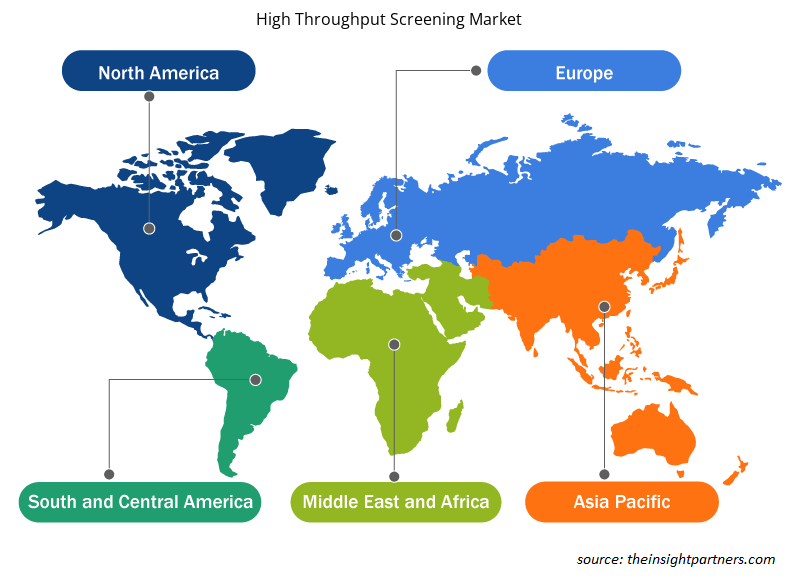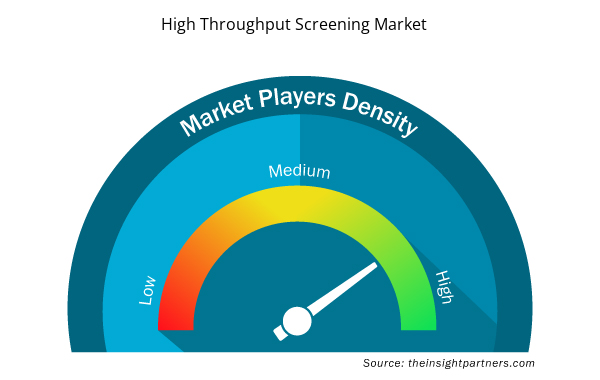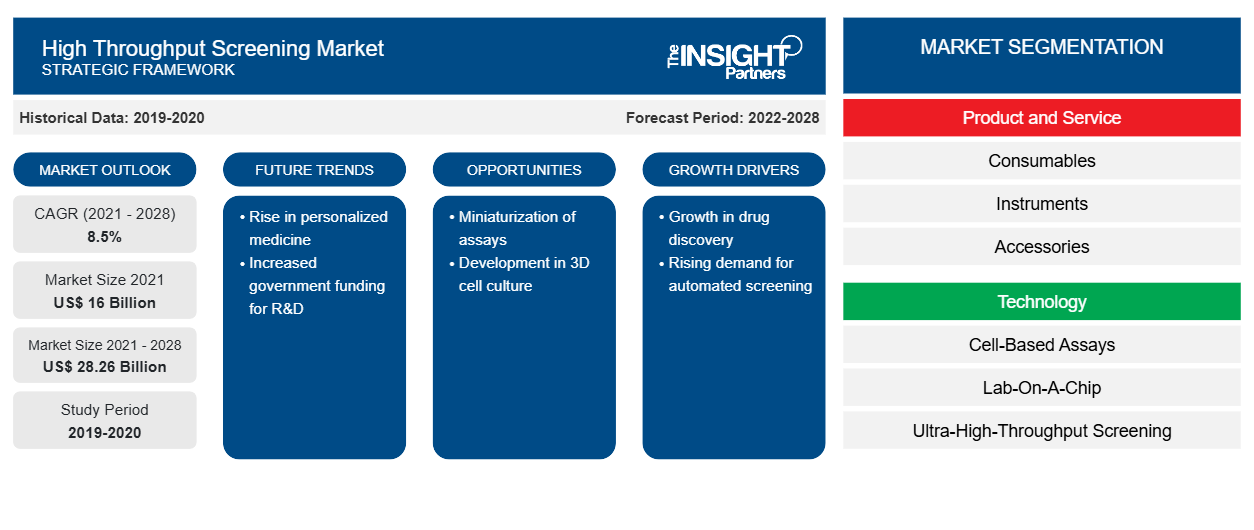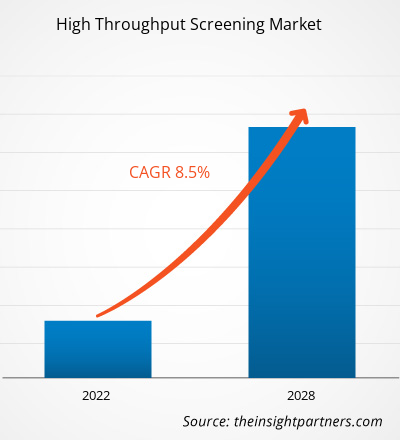Si prevede che il mercato dello screening ad alto rendimento raggiungerà i 28.255,71 milioni di dollari entro il 2028, rispetto ai 15.997,47 milioni di dollari del 2021. Si stima che il mercato crescerà con un CAGR dell'8,5% dal 2021 al 2028.
Lo screening ad alto rendimento (HTS) è un metodo di scoperta di farmaci che consente test automatizzati di vari composti chimici o biologici per un target biologico specifico. I metodi di screening ad alto rendimento sono ampiamente utilizzati nell'industria farmaceutica, sfruttando la robotica e l'automazione per testare rapidamente l'attività biologica o biochimica di un numero significativo di molecole, solitamente farmaci. Accelerano l'analisi del target, poiché librerie di composti su larga scala possono presto essere sottoposte a screening in modo economicamente vantaggioso. L'HTS è uno strumento prezioso per valutare i target farmacologici, profilare farmacologicamente agonisti e antagonisti per recettori (come GPCR) ed enzimi. Si prevede che fattori come un aumento degli investimenti in ricerca e sviluppo da parte dell'industria farmaceutica e biotecnologica e l'introduzione di prodotti tecnologicamente avanzati nel mercato dello screening ad alto rendimento stimoleranno la crescita del mercato nel corso degli anni. Tuttavia, l'elevato costo dello screening ad alto rendimento, la mancanza di professionisti qualificati e la complessità nello sviluppo dei test ostacoleranno probabilmente la crescita del mercato nei prossimi anni.
Approfondimenti di mercato
Aumento degli investimenti in ricerca e sviluppo da parte dell'industria farmaceutica e biotecnologica
Un aumento delle spese di R&S da parte di aziende farmaceutiche e biotecnologiche e importanti pipeline di farmaci per il trattamento di varie malattie croniche come disturbi cardiovascolari, cancro, disturbi immunologici, disturbi metabolici e disturbi neurologici sono fattori trainanti notevoli per il mercato dello screening ad alto rendimento. Diverse grandi e piccole aziende farmaceutiche sono coinvolte nello sviluppo e nella produzione di nuove molecole per diverse malattie potenzialmente letali. Ciò ha portato alla scelta di metodi di screening ad alto rendimento automatizzati (HTS) per lo screening di enormi librerie chimiche per soddisfare le esigenze di molecole target di farmaci in continua crescita. Ad esempio, un sistema di screening ad alto rendimento automatizzato può esaminare circa 10.000-100.000 composti target in un solo giorno. Le aziende farmaceutiche e biotecnologiche hanno investito notevolmente in tecniche di screening ad alto rendimento nell'ultimo decennio. Ad esempio, la famosa alleanza tra Millennium Pharmaceuticals, Inc. e Bayer AG ha scoperto con successo 18 nuovi target di farmaci e ne ha portati quattro allo screening ad alto rendimento in poco meno di otto mesi. L'alleanza adotta un nuovo approccio di produzione basato sulla ricerca genomica per portare le molecole nelle sperimentazioni cliniche il più rapidamente possibile. Lo screening ad alto rendimento è stato considerato una tecnologia fondamentale nel processo di scoperta dei farmaci. Ad esempio, oltre il 60% dei programmi di ottimizzazione della struttura principale completamente sviluppati di Boehringer Ingelheim sono dovuti all'implementazione di successo di HTS. Oltre 2,5 miliardi di dollari USA vengono spesi annualmente in prodotti HTS e servizi HTS solo negli Stati Uniti. Le grandi aziende farmaceutiche investono fino a 35 milioni di dollari USA all'anno in tecnologie di screening. Una quota significativa di questi investimenti viene destinata allo sviluppo di nuovi test.
Personalizza questo report in base alle tue esigenze
Riceverai la personalizzazione gratuita di qualsiasi report, comprese parti di questo report, o analisi a livello nazionale, pacchetto dati Excel, oltre a usufruire di grandi offerte e sconti per start-up e università
- Scopri le principali tendenze di mercato in questo rapporto.Questo campione GRATUITO includerà analisi di dati che spaziano dalle tendenze di mercato alle stime e alle previsioni.
Un numero crescente di target farmacologici per lo screening, utilizzato per la scoperta e lo sviluppo di farmaci, e i crescenti investimenti da parte di enti governativi e di ricerca stimoleranno ulteriormente l'adozione di tecniche HTS. Ad esempio, a dicembre 2020, un'organizzazione indipendente di ricerca su contratto preclinica e scoperta di farmaci integrata con sede nel Regno Unito, Sygnature Discovery, ha investito circa 4,12 milioni di dollari USA per rafforzare il suo servizio di screening ad alto rendimento (HTS) e oncologia traslazionale. Inoltre, programmi come "Tossicologia nel 21° secolo", una joint venture della FDA statunitense, dell'Environment Protection Agency e dell'Istituto nazionale della salute statunitense, utilizzano l'HTS automatizzato per testare sostanze chimiche, formulazioni e farmaci ambientali, per un esame tossicologico approfondito e per sviluppare percorsi specifici associati alla malattia per prevedere i livelli tossicologici. Tali iniziative sosterranno la proliferazione del mercato dello screening ad alto rendimento.
Approfondimenti basati su prodotti e servizi
In base al prodotto e al servizio, il mercato dello screening ad alto rendimento è suddiviso in materiali di consumo, strumenti, accessori, software e servizi. Nel 2021, il segmento dei materiali di consumo ha detenuto la quota maggiore del mercato e si prevede che assisterà al CAGR più rapido durante il periodo di previsione.
Copertura del rapporto
Approfondimenti basati sulla tecnologia
In base alla tecnologia, il mercato dello screening ad alto rendimento è segmentato in saggi basati su cellule, lab-on-a-chip, screening ad altissimo rendimento, bioinformatica e tecnologia senza etichetta. Nel 2021, il segmento dei saggi basati su cellule ha detenuto la quota maggiore del mercato, mentre si prevede che il segmento lab-on-a-chip crescerà al CAGR più rapido durante il periodo di previsione.
Approfondimenti basati sulle applicazioni
In base all'applicazione, il mercato dello screening ad alto rendimento è segmentato in drug discovery, screening biochimico, ricerca sulle scienze della vita e altre applicazioni. Nel 2021, il segmento drug discovery ha detenuto la quota maggiore del mercato e si prevede che crescerà al CAGR più rapido durante il periodo di previsione.
Informazioni basate sull'utente finale
In base all'utente finale, il mercato dello screening ad alto rendimento è segmentato in aziende farmaceutiche e biotecnologiche, istituti accademici e governativi, organizzazioni di ricerca a contratto (CRO) e altri. Nel 2021, il segmento delle aziende farmaceutiche e biotecnologiche ha detenuto la quota maggiore del mercato, mentre si prevede che il segmento delle organizzazioni di ricerca a contratto (CRO) crescerà al CAGR più rapido durante il periodo di previsione.
Diverse aziende che operano nel mercato dello screening ad alto rendimento stanno adottando strategie quali lanci di prodotti, fusioni e acquisizioni, collaborazioni, innovazioni di prodotto ed espansioni del portafoglio prodotti per espandere la propria presenza in tutto il mondo, mantenere il marchio e soddisfare la crescente domanda degli utenti finali.
Approfondimenti regionali sul mercato dello screening ad alto rendimento
Le tendenze regionali e i fattori che influenzano il mercato High Throughput Screening durante il periodo di previsione sono stati ampiamente spiegati dagli analisti di Insight Partners. Questa sezione discute anche i segmenti e la geografia del mercato High Throughput Screening in Nord America, Europa, Asia Pacifico, Medio Oriente e Africa e America meridionale e centrale.

- Ottieni i dati specifici regionali per il mercato dello screening ad alto rendimento
Ambito del rapporto di mercato sullo screening ad alto rendimento
| Attributo del report | Dettagli |
|---|---|
| Dimensioni del mercato nel 2021 | 16 miliardi di dollari USA |
| Dimensioni del mercato entro il 2028 | 28,26 miliardi di dollari USA |
| CAGR globale (2021 - 2028) | 8,5% |
| Dati storici | 2019-2020 |
| Periodo di previsione | 2022-2028 |
| Segmenti coperti | Per prodotto e servizio
|
| Regioni e Paesi coperti | America del Nord
|
| Leader di mercato e profili aziendali chiave |
|
Densità degli attori del mercato dello screening ad alto rendimento: comprendere il suo impatto sulle dinamiche aziendali
Il mercato High Throughput Screening Market sta crescendo rapidamente, spinto dalla crescente domanda degli utenti finali dovuta a fattori quali l'evoluzione delle preferenze dei consumatori, i progressi tecnologici e una maggiore consapevolezza dei vantaggi del prodotto. Con l'aumento della domanda, le aziende stanno ampliando le loro offerte, innovando per soddisfare le esigenze dei consumatori e capitalizzando sulle tendenze emergenti, il che alimenta ulteriormente la crescita del mercato.
La densità degli operatori di mercato si riferisce alla distribuzione di aziende o società che operano in un particolare mercato o settore. Indica quanti concorrenti (operatori di mercato) sono presenti in un dato spazio di mercato in relazione alle sue dimensioni o al valore di mercato totale.
Le principali aziende che operano nel mercato dello screening ad alta produttività sono:
- Agilent Technologies, Inc.
- Axxam SPA
- Eurofins Scientific
- Corning Incorporata
- Dispositivi molecolari, LLC.
Disclaimer : le aziende elencate sopra non sono classificate secondo un ordine particolare.

- Ottieni una panoramica dei principali attori del mercato dello screening ad alto rendimento
Mercato dello screening ad alto rendimento – per prodotto e servizio
- Materiali di consumo
- Reagenti e kit di analisi
- Attrezzatura da laboratorio
- Strumenti
- Sistemi di movimentazione dei liquidi
- Sistemi di rilevamento
- Accessori
- Software
- Servizi
Mercato dello screening ad alto rendimento – per tecnologia
- Analisi basate sulle cellule
- Laboratorio su chip
- Screening ad altissima produttività
- Bioinformatica
- Tecnologia senza etichetta
- Risonanza plasmonica di superficie
- Interferometria Riflettente
- Calorimetria di titolazione isotermica
- Calorimetria differenziale a scansione
- Microcantilever
- Nanotubi di carbonio
- Cristalli fotonici
- Altri
Mercato dello screening ad alto rendimento – per applicazione
- Scoperta di farmaci
- Screening biochimico
- Ricerca in scienze della vita
- Altre applicazioni
Mercato dello screening ad alto rendimento – per utente finale
- Aziende farmaceutiche e biotecnologiche
- Istituti accademici e governativi
- Organizzazioni di ricerca a contratto (CRO)
- Altri
Mercato dello screening ad alto rendimento – per area geografica
America del Nord
- NOI
- Canada
- Messico
Europa
- Francia
- Germania
- Italia
- Regno Unito
- Spagna
- Resto d'Europa
Asia Pacifico (APAC)
- Cina
- India
- Corea del Sud
- Giappone
- Australia
- Resto dell'Asia Pacifica
Medio Oriente e Africa (MEA)
- Sudafrica
- Arabia Saudita
- Emirati Arabi Uniti
- Resto del Medio Oriente e Africa
America del Sud (SAM)
- Brasile
- Argentina
- Resto del Sud e Centro America
Profili aziendali
- Agilent Technologies, Inc.
- Axxam SPA
- Eurofins Scientific
- Corning Incorporata
- Dispositivi molecolari, LLC.
- Azienda Hamilton
- Gruppo Merck
- Perkinelmer, Inc.
- Gruppo Tecan
- Thermo Fisher Scientific Inc.
- Analisi storica (2 anni), anno base, previsione (7 anni) con CAGR
- Analisi PEST e SWOT
- Valore/volume delle dimensioni del mercato - Globale, regionale, nazionale
- Industria e panorama competitivo
- Set di dati Excel


- Bioremediation Technology and Services Market
- Smart Mining Market
- Microplate Reader Market
- Aircraft MRO Market
- Integrated Platform Management System Market
- Space Situational Awareness (SSA) Market
- Grant Management Software Market
- Enteral Nutrition Market
- Hand Sanitizer Market
- Nuclear Decommissioning Services Market

Report Coverage
Revenue forecast, Company Analysis, Industry landscape, Growth factors, and Trends

Segment Covered
This text is related
to segments covered.

Regional Scope
North America, Europe, Asia Pacific, Middle East & Africa, South & Central America

Country Scope
This text is related
to country scope.
Domande frequenti
Key factors that are driving the growth of this market increase in investment in research and development by the pharmaceutical and biotechnology industry and the introduction of technologically advanced products in the high throughput screening.
The pharmaceutical and biotechnology companies segment dominated the global high-throughput screening market and accounted for the largest revenue share of 45.27% in 2021.
High-throughput screening (HTS) is a drug discovery process that allows automated testing of large numbers of chemical and/or biological compounds for a specific biological target. High-throughput screening methods are extensively used in the pharmaceutical industry, leveraging robotics and automation to quickly test the biological or biochemical activity of a large number of molecules, usually drugs. They accelerate target analysis, as large-scale compound libraries can quickly be screened in a cost-effective way. HTS is a useful tool for assessing for instance pharmacological targets, pharmacologically profiling agonists and antagonists for receptors (such as GPCRs) and enzymes.
The consumables segment dominated the global high-throughput screening market and held the largest revenue share of 44.85% in 2021.
Global high-throughput screening market is segmented by region into North America, Europe, Asia Pacific, Middle East & Africa and South & Central America. In North America, the U.S. is the largest market for high-throughput screening. The US is estimated to hold the largest share in the high-throughput screening market during the forecast period. The growth of the market can be because of prevalence of various diseases, government support for biotechnology and increasing efforts in R&D activities as well as other activities undertaken by the market players operating in the market. In addition, technologically advanced products are likely to stimulate the growth of high-throughput screening market in North America. On the other hand, large pool of population suffering with chronic diseases, rapidly developing healthcare infrastructure, and intellectual capabilities of scientists and researchers in the Asia Pacific is expected to account for the fastest growth of the region during the coming years.
The high-throughput screening market majorly consists of the players such Agilent Technologies, Inc., Axxam S.P.A., Eurofins Scientific, Corning Incorporated, Molecular Devices, LLC., Hamilton Company, Merck Group, Perkinelmer, Inc., Tecan Group and Thermo Fisher Scientific Inc. among others.
Trends and growth analysis reports related to Life Sciences : READ MORE..
The List of Companies - High Throughput Screening Market
- Agilent Technologies, Inc.
- Axxam S.P.A.
- Eurofins Scientific
- Corning Incorporated
- Molecular Devices, LLC.
- Hamilton Company
- Merck Group
- Perkinelmer, Inc.
- Tecan Group
- Thermo Fisher Scientific Inc.
The Insight Partners performs research in 4 major stages: Data Collection & Secondary Research, Primary Research, Data Analysis and Data Triangulation & Final Review.
- Data Collection and Secondary Research:
As a market research and consulting firm operating from a decade, we have published and advised several client across the globe. First step for any study will start with an assessment of currently available data and insights from existing reports. Further, historical and current market information is collected from Investor Presentations, Annual Reports, SEC Filings, etc., and other information related to company’s performance and market positioning are gathered from Paid Databases (Factiva, Hoovers, and Reuters) and various other publications available in public domain.
Several associations trade associates, technical forums, institutes, societies and organization are accessed to gain technical as well as market related insights through their publications such as research papers, blogs and press releases related to the studies are referred to get cues about the market. Further, white papers, journals, magazines, and other news articles published in last 3 years are scrutinized and analyzed to understand the current market trends.
- Primary Research:
The primarily interview analysis comprise of data obtained from industry participants interview and answers to survey questions gathered by in-house primary team.
For primary research, interviews are conducted with industry experts/CEOs/Marketing Managers/VPs/Subject Matter Experts from both demand and supply side to get a 360-degree view of the market. The primary team conducts several interviews based on the complexity of the markets to understand the various market trends and dynamics which makes research more credible and precise.
A typical research interview fulfils the following functions:
- Provides first-hand information on the market size, market trends, growth trends, competitive landscape, and outlook
- Validates and strengthens in-house secondary research findings
- Develops the analysis team’s expertise and market understanding
Primary research involves email interactions and telephone interviews for each market, category, segment, and sub-segment across geographies. The participants who typically take part in such a process include, but are not limited to:
- Industry participants: VPs, business development managers, market intelligence managers and national sales managers
- Outside experts: Valuation experts, research analysts and key opinion leaders specializing in the electronics and semiconductor industry.
Below is the breakup of our primary respondents by company, designation, and region:

Once we receive the confirmation from primary research sources or primary respondents, we finalize the base year market estimation and forecast the data as per the macroeconomic and microeconomic factors assessed during data collection.
- Data Analysis:
Once data is validated through both secondary as well as primary respondents, we finalize the market estimations by hypothesis formulation and factor analysis at regional and country level.
- Macro-Economic Factor Analysis:
We analyse macroeconomic indicators such the gross domestic product (GDP), increase in the demand for goods and services across industries, technological advancement, regional economic growth, governmental policies, the influence of COVID-19, PEST analysis, and other aspects. This analysis aids in setting benchmarks for various nations/regions and approximating market splits. Additionally, the general trend of the aforementioned components aid in determining the market's development possibilities.
- Country Level Data:
Various factors that are especially aligned to the country are taken into account to determine the market size for a certain area and country, including the presence of vendors, such as headquarters and offices, the country's GDP, demand patterns, and industry growth. To comprehend the market dynamics for the nation, a number of growth variables, inhibitors, application areas, and current market trends are researched. The aforementioned elements aid in determining the country's overall market's growth potential.
- Company Profile:
The “Table of Contents” is formulated by listing and analyzing more than 25 - 30 companies operating in the market ecosystem across geographies. However, we profile only 10 companies as a standard practice in our syndicate reports. These 10 companies comprise leading, emerging, and regional players. Nonetheless, our analysis is not restricted to the 10 listed companies, we also analyze other companies present in the market to develop a holistic view and understand the prevailing trends. The “Company Profiles” section in the report covers key facts, business description, products & services, financial information, SWOT analysis, and key developments. The financial information presented is extracted from the annual reports and official documents of the publicly listed companies. Upon collecting the information for the sections of respective companies, we verify them via various primary sources and then compile the data in respective company profiles. The company level information helps us in deriving the base number as well as in forecasting the market size.
- Developing Base Number:
Aggregation of sales statistics (2020-2022) and macro-economic factor, and other secondary and primary research insights are utilized to arrive at base number and related market shares for 2022. The data gaps are identified in this step and relevant market data is analyzed, collected from paid primary interviews or databases. On finalizing the base year market size, forecasts are developed on the basis of macro-economic, industry and market growth factors and company level analysis.
- Data Triangulation and Final Review:
The market findings and base year market size calculations are validated from supply as well as demand side. Demand side validations are based on macro-economic factor analysis and benchmarks for respective regions and countries. In case of supply side validations, revenues of major companies are estimated (in case not available) based on industry benchmark, approximate number of employees, product portfolio, and primary interviews revenues are gathered. Further revenue from target product/service segment is assessed to avoid overshooting of market statistics. In case of heavy deviations between supply and demand side values, all thes steps are repeated to achieve synchronization.
We follow an iterative model, wherein we share our research findings with Subject Matter Experts (SME’s) and Key Opinion Leaders (KOLs) until consensus view of the market is not formulated – this model negates any drastic deviation in the opinions of experts. Only validated and universally acceptable research findings are quoted in our reports.
We have important check points that we use to validate our research findings – which we call – data triangulation, where we validate the information, we generate from secondary sources with primary interviews and then we re-validate with our internal data bases and Subject matter experts. This comprehensive model enables us to deliver high quality, reliable data in shortest possible time.


 Ottieni un campione gratuito per questo repot
Ottieni un campione gratuito per questo repot